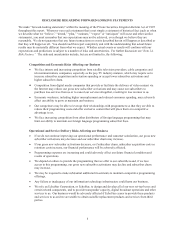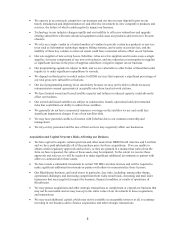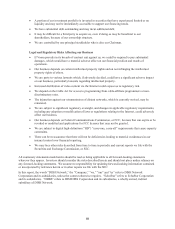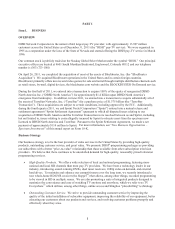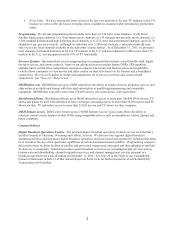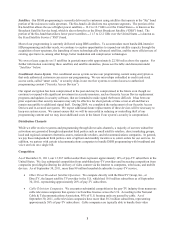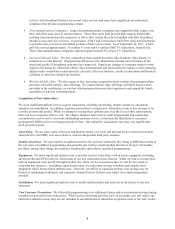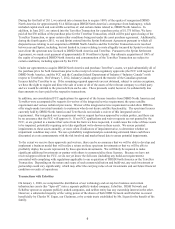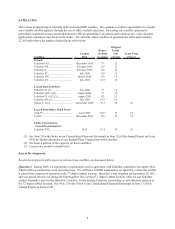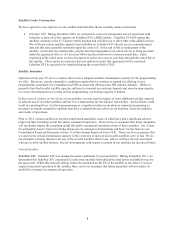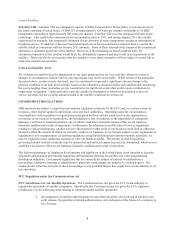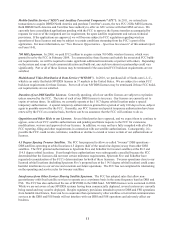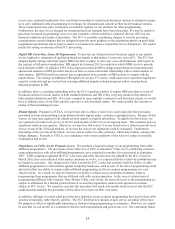Dish Network 2011 Annual Report Download - page 13
Download and view the complete annual report
Please find page 13 of the 2011 Dish Network annual report below. You can navigate through the pages in the report by either clicking on the pages listed below, or by using the keyword search tool below to find specific information within the annual report.3
3
Satellites. Our DISH programming is currently delivered to customers using satellites that operate in the “Ku” band
portion of the microwave radio spectrum. The Ku-band is divided into two spectrum segments. The portion of the
Ku-band that allows the use of higher power satellites ̛ 12.2 to 12.7 GHz over the United States ̛ is known as the
Broadcast Satellite Service band, which is also referred to as the Direct Broadcast Satellite (“DBS”) band. The
portion of the Ku-band that utilizes lower power satellites ̛ 11.7 to 12.2 GHz over the United States ̛ is known as
the Fixed Satellite Service (“FSS”) band.
Most of our programming is currently delivered using DBS satellites. To accommodate more bandwidth-intensive
HD programming and other needs, we continue to explore opportunities to expand our satellite capacity through the
acquisition of new spectrum, the launching of more technologically advanced satellites, and the more efficient use of
existing spectrum via, among other things, better modulation and compression technologies.
We own or lease capacity on 13 satellites in geostationary orbit approximately 22,300 miles above the equator. For
further information concerning these satellites and satellite anomalies, please see the table and discussion under
“Satellites” below.
Conditional Access System. Our conditional access system secures our programming content using encryption so
that only authorized customers can access our programming. We use microchips embedded in credit card-sized
access cards, called “smart cards,” or security chips in our receiver systems to control access to authorized
programming content (“Security Access Devices”).
Our signal encryption has been compromised in the past and may be compromised in the future even though we
continue to respond with significant investment in security measures, such as Security Access Device replacement
programs and updates in security software, that are intended to make signal theft more difficult. It has been our
prior experience that security measures may only be effective for short periods of time or not at all and that we
remain susceptible to additional signal theft. During 2009, we completed the replacement of our Security Access
Devices and re-secured our system. We expect additional future replacements of these devices will be necessary to
keep our system secure. We cannot ensure that we will be successful in reducing or controlling theft of our
programming content and we may incur additional costs in the future if our system’s security is compromised.
Distribution Channels
While we offer receiver systems and programming through direct sales channels, a majority of our new subscriber
activations are generated through independent third parties such as small satellite retailers, direct marketing groups,
local and regional consumer electronics stores, nationwide retailers, and telecommunications companies. In general,
we pay these independent third parties a mix of upfront and monthly incentives to solicit orders for our services. In
addition, we partner with certain telecommunications companies to bundle DISH programming with broadband and
voice services on a single bill.
Competition
As of December 31, 2011, our 13.967 million subscribers represent approximately 14% of pay-TV subscribers in the
United States. We face substantial competition from established pay-TV providers and increasing competition from
companies providing/facilitating the delivery of video content via the Internet to computers, televisions, and mobile
devices. As of September 30, 2011, more than 99 million households subscribe to a pay-TV service.
x Other Direct Broadcast Satellite Operators. We compete directly with the DirecTV Group, Inc., or
DirecTV, the largest satellite TV provider in the U.S. which had 19.8 million subscribers as of September
30, 2011, representing approximately 20% of pay-TV subscribers.
x Cable Television Companies. We encounter substantial competition in the pay-TV industry from numerous
cable television companies that operate via franchise licenses across the U.S. According to the National
Cable & Telecommunications Association, 98% of U.S. housing units are passed by cable. As of
September 30, 2011, cable television companies have more than 58.3 million subscribers, representing
approximately 58% of pay-TV subscribers. Cable companies are typically able to bundle their video







